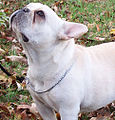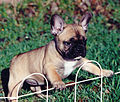French Bulldog Coat Color Genetics – Brindle
Dexter is a brindle French Bulldog with a black mask
Brindle is, in the most simplistic terms, a pattern of stripes overlaying the coat of a dog.
In French Bulldogs, these stripes are generally black, and can vary in width from extremely thick, resulting in a dog who appears to be almost completely black ( a coat color which in French Bulldogs is referred to as “seal brindle”) to extremely thin, resulting in a dog who is almost completely fawn, with a few thin stripes of black overlaying their coat (in French Bulldogs, this is usually called “reverse brindle”).
The genetics of brindling are much more complex than early research had assumed them to be. Almost fifty years later, C.C. Little’s early research into canine coat color genetics is just now beginning to be over turned, thanks to developments into DNA based coat color research. Little believed that brindling was a simple dominant/recessive allele carried along with the “E” locus for coat color. New DNA research indicates that the allele brindle is actually part of the “K” series.
So, here we have a simple break down of the genetics of brindle. Most of this is taken from the very excellent coat color genetics website maintained by Dr. Sheila M. Schmutz, of the University of Saskatchewan.
For a French Bulldog to be brindle, a few other genes have to come into play.
First of all, French Bulldogs have to have the “KB” allele, which allows for the formation of black pigment.
The K allele has the following modifiers —
KB, as noted above, allows for the formation of black.
K br is the exact modifier which allows for the formation of brindling patterns
However, we’re not done yet.
A dog can ONLY be brindle if they also have an E or Em allele. Dogs which have the E allele are not masked, dogs with the Em allele are masked (this can be hidden by the brindling pattern, and not visible to the eye, but is still genetically present). If the dog is e/e, they can NOT be brindle, and can not have a mask.
So, a dog such as the one to our left, which looks, to the eye of a layperson, to be a simple “black” dog, is in actual fact a fawn dog (because of the e or E allele) with brindle patterning (because of the K br allele), with or without a black mask (Em).
As well, this dog might also be carrying the gene for large areas of white markings – better known to us as ‘pied’ (sp), or the gene for ‘Irish Spotting’ – better known to us as “Boston Marked” French Bulldogs (si).
A dog carrying both the Kbr allele and two copies of the spallele will be a brindle pied dog, as illustrated by the dog to the left.
Because I know the coat colors of both of this dog’s parents, and because I know that he has produced variously colored and/or patterned offspring, from breedings to variously colored/patterned bitches, I can speculate that Rebel was a non dominant brindle dog with the masking gene, and the genes for both pied and Irish Spotting –
Kbr/K EM/E si/ssp
All of this is what makes me personally find Brindle dogs to be the most fascinating and useful color for dog breeders. They have the potential for so much hidden genetics! Your run of the mill brindle dog (which so many novices pass over as ‘boring’) can also be carrying the masking gene, the pied gene or both the genes for white marking patterns.
Genetically, a brindle dog could be any of the following:
E/EM kbr/kbr Si/Si
– this is a brindle dominant dog (two brindle genes) with a black mask, who is also pied
E/EM kbr/kbr S/Si
– this is a brindle dominant dog (two brindle genes) with a black mask who carries the gene for pied (but is not pied themselves)
E/e k/kbr S/S
– this is a brindle dog carrying only one brindle gene, without a black mask, and not carrying the gene for pied or irish spotting
…. etc
Knowing, with a reasonable guess, the coat color genetics of both of the dog’s parents will help you to determine his hidden color genetics, but you won’t really ever know for sure what he is carrying until he has produced several litters, from several bitches of several colors.
Note that there are also possibilities for many of the alleles mentioned above – K can be Ky/Ky, which gives possible expression to the ‘Black and Tan’ phenotype, depending on the interactions with the agouti allele, dogs can be e/e, with no brindling or masking possible, etc… Some of these have been skipped as I plan to discuss them in other coat color postings.



 For true excitement, however, we need to talk about the red headed step child of the French Bulldog world – Blue French Bulldogs. Few things can cause more heated exchanges of opinion than the topic of Blue (aka Mouse, aka Dilute, aka Devil Dogs).
For true excitement, however, we need to talk about the red headed step child of the French Bulldog world – Blue French Bulldogs. Few things can cause more heated exchanges of opinion than the topic of Blue (aka Mouse, aka Dilute, aka Devil Dogs). Plaid French Bulldogs are the most super awesomest dogs alive today.
Plaid French Bulldogs are the most super awesomest dogs alive today.












